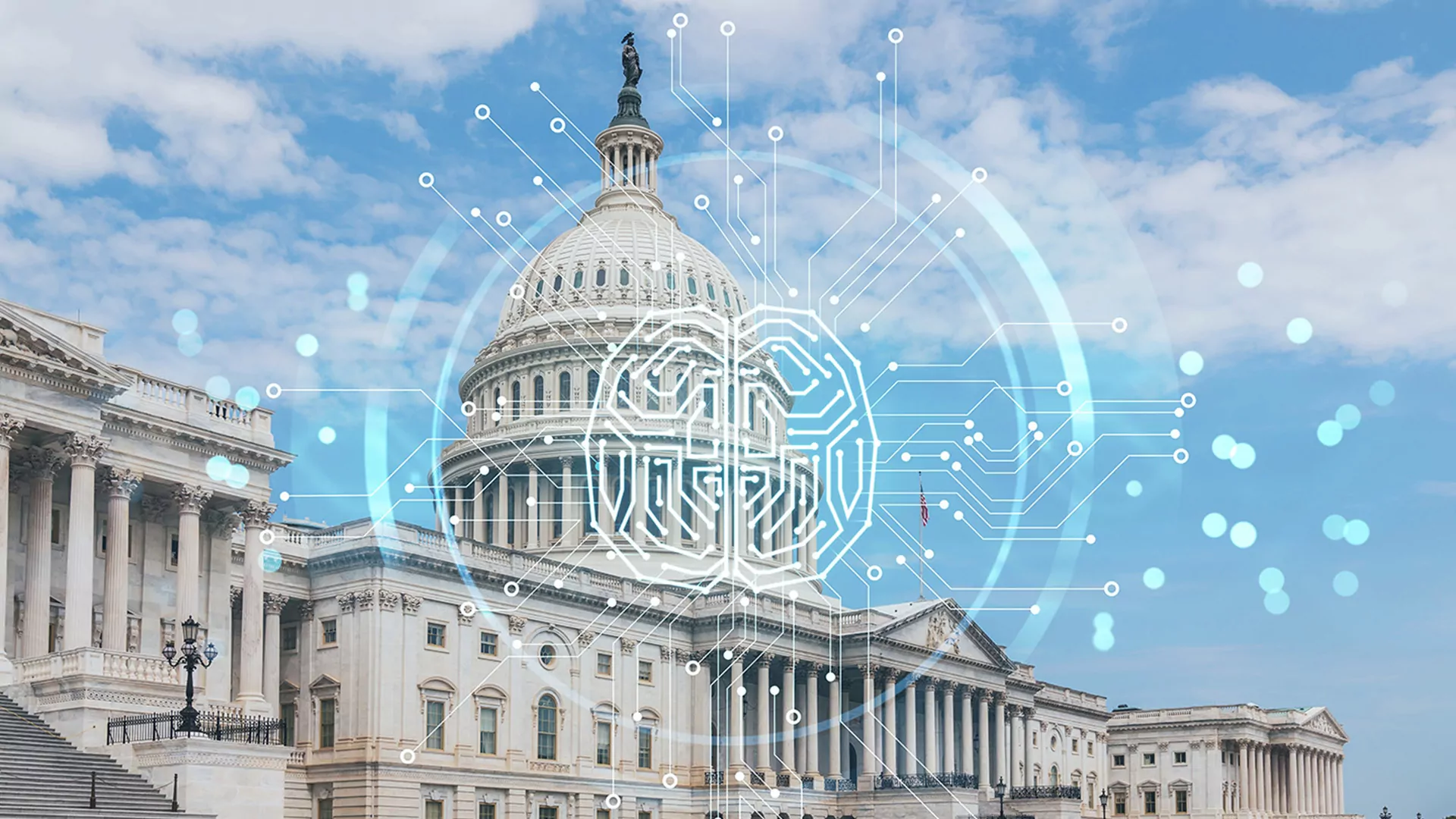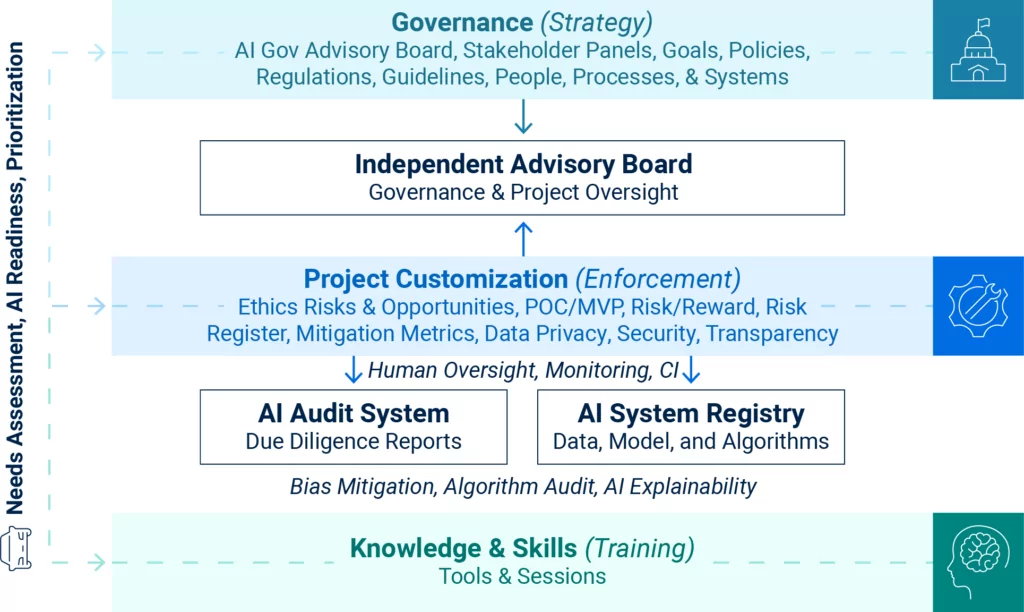Introduction
As the digital revolution continues to accelerate, government entities at all levels recognize Artificial Intelligence (AI) as a transformative agent that is reimagining public sector services, ranging from Citizen Self-Services to intelligent automation that address operations inefficiencies and pain points. While AI’s potential to transform public sector services is undeniable, the challenge lies not just in harnessing AI’s vast capabilities but in doing so ethically and responsibly. This means proactively addressing potential risks to both citizens and governmental agencies through the establishment of comprehensive governance structures and guardrails that ensure the ethical and responsible use of AI.
This white paper presents a roadmap for government agencies in ensuring the ethical and responsible use of AI for the next generation of citizen services. By providing actionable strategies and ethical considerations, this roadmap aims to create an environment where AI contributes to public services while adhering to ethical principles and regulatory frameworks.

Applications of AI in Government
AI is revolutionizing government operations at all levels. It automates routine tasks, improves customer interactions, increases operational efficiency, and shifts employee tasks to higher-value work.

Specific AI case studies across government include:
Federal Emergency Management Agency (FEMA): Uses AI/machine learning (ML) to scrutinize satellite and social media data, allowing for a quicker evaluation of disaster-induced damages. This swift assessment ensures a more targeted allocation of resources during critical emergencies.
U.S. Citizenship and Immigration Services (USCIS): Leverages AI/ML to refine the asylum seeker application process. The tools help in assessing submission data quality, verifying fingerprints, and cross-checking documentation. As a result, there is a noticeable reduction in wait times from automated application processing and adjudication.
Internal Revenue Service (IRS): Deploys AI/ML tools to discern tax fraud patterns, thus proactively discouraging tax evasion while generating greater tax revenues.
Department of Homeland Security (DHS) and National Security Agency (NSA): Use AI/ML to detect and understand suspicious cyber activities. This proactive approach offers insights into potential cyber threats and enhances digital defenses.
National Institutes of Health (NIH) and Centers for Disease Control and Prevention (CDC): Harnesses AI/ML to process vast amounts of medical data. The insights drawn from AI help pinpoint health trends, anticipate disease outbreaks, augment patient care, and fine-tune diagnostic methods.
Food and Drug Administration (FDA): Explores the benefits of AI in data mining and pattern detection, with an aim to foresee risks during electronic screenings of shipments arriving in the U.S.
Various Agencies: AI-driven chatbots have been adopted to uplift the quality of citizen help- desk services. Notably, these chatbots have even found applications in space, supporting NASA astronauts with real-time information during missions.
Such success stories from agencies show how AI is transforming government operations. As we move towards modernization of government operations, we must also proceed with care to ensure AI is used ethically and responsibility. Setting strong guidelines and safeguards is essential to protecting both citizens from harm and agencies from liability.

The next steps include instituting measures such as the AI Bill of Rights, the AI Risk Management Framework, and charting a plan for a national AI research resource.
Key Principles for Ethical AI Use in Government
To adopt AI responsibly into governmental processes, agencies need strong ethical foundations. Agencies should collaborate to define ethical guidelines that mirror societal values and norms. They should place the following principles at the forefront of these discussions.
Transparency: Agencies should be transparent about their AI use, including the data sources, algorithms employed, and decisions made. This fosters trust and clarity between the government and its citizens.
Accountability: Mechanisms must exist to hold agencies accountable for their AI use. This can include independent oversight bodies, regular public reporting, and clear responsibilities designated within agencies.
Fairness: AI systems must be designed with fairness in mind, ensuring they do not favor or prejudice against any particular group.
Non-discrimination: AI must not be used in ways that could lead to discriminatory impacts on individuals or groups. This requires constant monitoring and evaluation of AI outputs against set standards.
Privacy: Protecting individual privacy is paramount. Agencies must ensure the data used by AI systems respect privacy norms and regulations.
Roadmap to Responsible and Ethical Applications of AI
For a responsible adoption of AI into governmental processes, strong ethical foundations are imperative. Agencies must work together in delineating ethical guidelines that reflect societal values and norms. Principles such as fairness, transparency, accountability, and a deep understanding of AI’s societal implications should be at the forefront of these discussions.
Figure 1: Roadmap to Responsible and Ethical AI
Figure 1 illustrates the three primary avenues of the roadmap, namely Governance (Strategy), Product/ Project specific customization (Enforcement), and Knowledge and Skills development (Training). Each of these avenues are connected and traversed with steps designed to establish a robust framework for effective enforcement of responsible and ethical AI governance.
Governance (Strategy): Agencies should establish a cross-functional Responsible and Ethical
AI Governance team that comprises of AI experts, legal advisors, ethicists, and representatives from diverse government departments. This team can collectively design policies, guidelines, and mechanisms for overseeing AI adoption.
For fairness, transparency, and trust, it is important to involve the public and stakeholders. Agencies should form an independent AI ethics advisory board, including policymakers, data experts, public officials, and citizens to influence governance. This board should review technical AI audit reports and AI system registries for oversight, focusing on bias reduction and AI clarity. Clear roles ensure smooth communication, teamwork, and enforcement.
Government agencies should establish channels for public participation and feedback. Town hall meetings, online platforms, and surveys can gather citizen input on AI adoption, enhancing responsibility, transparency, and responsiveness.

Experienced AI vendors can quickly create a pilot project (proof-of-concept or MVP) to evaluate user story backlogs and the AI technology’s capabilities using a risk versus reward matrix. An assessment of risks to an Agency with a risk register and mitigation metrics, including but not limited to, security, reputational, ethical, and legal risk will help with enforcement of regulations and policies.
Protecting data is essential when adopting AI. Agencies should implement robust data governance frameworks covering data collection, storage, processing, sharing, and must adhere to regulations such as the General Data Protection Regulation (GDPR).
Before operational deployment, thorough testing is key. Agencies should review pilot projects to understand AI’s real-world effects. Agile feedback loops should be established, allowing iterative improvements to MVPs based on the assessment of the pilot projects.
Transparency in AI decisions builds trust. Government agencies should adopt tools and techniques that provide explanations for AI decisions in understandable terms. Techniques like model interpretability can be integrated to enhance transparency.
While AI automates and streamlines tasks, human oversight is essential. Agencies should establish accountability mechanisms that involve human experts in critical AI decisions. Such measures ensure that ethical considerations are upheld and that automated systems do not perpetuate unintended biases or unfairness.
Bias mitigation requires proactive steps. Agencies should implement techniques for auditing AI algorithms to detect and mitigate biases. This involves developing diverse and representative datasets, fine-tuning models, and regularly assessing for biases throughout the AI lifecycle.

Knowledge and Skills Development (Training): To foster responsible AI adoption, training is essential for government personnel and stakeholders. Agencies should invest in training and awareness programs that educate stakeholders about AI concepts, applications, including the potential benefits and risks. Workshops, seminars, and educational self-learning resources can be made available to instill the required understanding. Training programs should include educating the workforce about AI concepts, implications, and ethical considerations. Ensuring the workforce understands AI thoroughly equips them to make informed decisions surrounding its use.
Conclusion
As we stand on the brink of an AI-powered era, it is crucial for governments to not only harness the full potential of AI but to also do so with ethics, fairness, and transparency. By following this roadmap, government agencies can seamlessly navigate the complexities of AI adoption, ensuring that technology is harnessed ethically, aligned with societal values, and contributes to the next generation of responsible government operations.
To fully realize the benefits of this transformative technology, it is imperative to remain vigilant and proactive against its challenges. With the right guidelines, consistent training, vigilant oversight, and public engagement, AI can truly transform the next generation of government operations into a paradigm of responsibility, efficiency, and ethics.
Finally, we encourage agency IT leaders to collaborate, innovate, and invest in AI initiatives by partnering with vendors who grasp the significance of ethical use of AI and have a proven track record in assisting agencies with responsible AI implementation. As AI continues to evolve and you embark on your quest to redefine future government operations, we hope this roadmap serves as a useful guide to the responsible and ethical application of AI.
Want to accelerate your agency’s use of AI? Reach out today at info@reisystems.com to explore how our experts offer expertise in the best-proven technologies that advance public missions.








